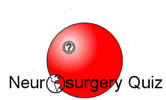
Babaji
NSQ 3, December 2003
Editor:
G Narenthiran, Bsc(MedSci), MB ChB (Aberd.), MRCS(Edin.), Senior
SHO, Hull Royal Infirmary, Hull UK
E-mail: g_narenthiran@hotmail.com
Acknowledgements:
|
Dr Mustafa K Baskaya, MD (Miami, US): mkbaskaya@yahoo.com |
Q1-4 |
| Dr Rupert
Clifton, MRCS (Hull, UK): ugm5grec@hotmail.com |
Q 5 |
Q1. Which of the following statement(s) is/are false regarding
neurofibramatosis 1 (NF1)?
| i) |
Thirty to 60% of patients with NF1 demonstrate hyperintense lesion on T2-weighted MRI in the basal ganglia, thalamus, cerebellum, and brain stem and these lesion are called un-identified bright objects. |
| ii) |
An association was demonstrated between these lesions and learning disabilities in children with NF1. |
| iii) |
Histopathology of these lesions consists of increased water content, dysplasia and hamartomatous changes. |
| iv) |
Cutaneous neurofibromas in NF1 DO NOT transform into malignant cases. |
| v) |
Plexiform neurofibromas appear in preadolescence and do not undergo malignant degeneration. |
| a. | i |
| b. | iii |
| c. | iii & iv |
| d. | v |
| e. | iii & v |
Q2. Which
nerve/nerves originate from the ventral rami of the roots before the formation
of the brachial plexus?
i) |
Dorsal scapular nerve |
ii) |
Suprascapular nerve |
iii) |
Long thoracic nerve |
iv) |
Lateral pectoral nerve |
v) |
Upper subscapular nerve |
| a. | i |
| b. | ii |
| c. | iii |
| d. | i & iii |
| e. | i & v |
Q3. All of the following are correct regarding anatomy of the facial nerve EXCEPT?
|
i) |
Facial nerve contains special visceral afferent fibers for the muscles of facial expression, the stapedius muscle, stylohyoid muscle and posterior belly of digastric. |
|
ii) |
Nervus intermedius, also known as the nerve of Wrisberg, is collection of only parasympathetic fibers (lacrimal gland, submandibular and sublingual glands). |
|
iii) |
Greater superficial petrosal nerve (GSPN) exits facial nerve at geniculate ganglion level |
|
iv) |
GSPN joins deep petrosal nerve to form vidian nerve. |
|
v). |
Blood supply to the facial nerve comes from the AICA, middle meningeal artery, and postauricular artery. |
| a. | i |
| b. | ii |
| c. | iii |
| d. | iv |
| e. | v |
Q4. All of the statements are correct regarding paraneoplastic cerebellar degeneration EXCEPT?
| i) |
It is the most common remote effect of neoplasm affecting the brain. |
| ii) |
It is associated with lung, ovarian, and breast Ca and Hodgkin’s disease. |
| iii) |
The symptoms may progress slowly and patients develops asymmetrical cerebellar syndrome. |
| iv) |
Histopathologically, there is a severe loss of Purkinje cells. |
| v) |
Two main antibodies are found in patients’ sera and CSF; namely Yo and Hu antibodies. |
| a. | i |
| b. | ii |
| c. | iii |
| d. | iv |
| e. | v |
Q5. The
incidence of posterior fossa AVMs is 20-30% of ALL cranial AVMs?
| True | False |
Explanation:
Pathology of these lesion (UBOs) showed increased water content but not dysplasia
or hamartoma.
Plexiform neurofibromas are
almost always congenital lesions and can undergo into malignant transformation.
Gutmann DH et al. The diagnostic evaluation and multidisciplinary
management of neurofibromatosis 1 and neurofibromatosis 2. JAMA
278:51-57, 1997
A2.
Answer is 'd' (i & iii)
Explanation:
Differentiation of root lesion from plexus lesion is possible by testing one
of these nerves (dorsal scapular nerve, C5, to rhomboid and levator muscles
which elevate and stabilize the scapula and long thoracic nerve, C5,6,7, to
serratus anterior which
abducts the scapula).
Tindall B: Aids to the Examination of the Peripheral Nervous System. London,
WB Saunders, 1990.
A3.
Answer is 'b' (ii)
Explanation:
Nervus intermedius is not
only collection of parasympathetic fibers but also contains sensory fibers (external
ear cutaneous sensation and taste).
LaRouere MJ and Lundy LB. Anatomy and physiology of the facial
nerve. In: Neurotology. Jackler RK and Brackmann DE (Eds). Mosby, St. Louis,
1994.
A4.
Answer is 'c' (iii)
Explanation:
The symptoms usually progress rapidly to severe and symmetric truncal and limb
ataxia with dysarthria and nystagmus. Cerebellar sypmtoms may improve in some
patients when causative neoplasms are removed.
Lai EC. Paraneoplastic syndromes. In Rolak LA, harati Y (eds):
Neuro-immunology for the Clinician. Boston, Butterworth-Heinemann,1997.
A5. Answer
is 'False'
Posterior fossa AVM account for 7-18% of all intracranial AVM.
Symon L, Tacconi
L, Mendoza N, et al: Arteriovenous malformations of the posterior fossa: a report
on 28 cases and review of the literature. Br
J Neurosurg 9:721-732. 1995
© Annals of Neurosurgery, 2003